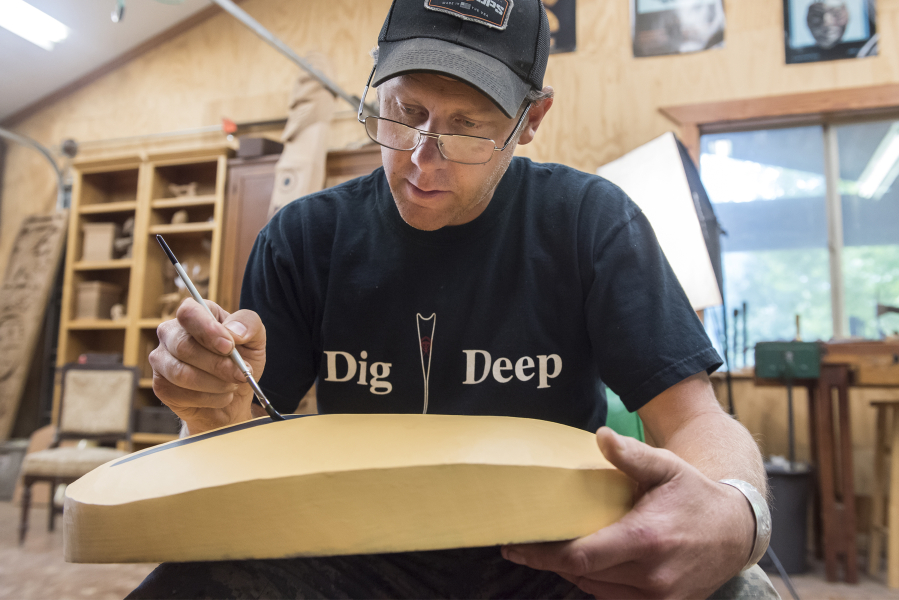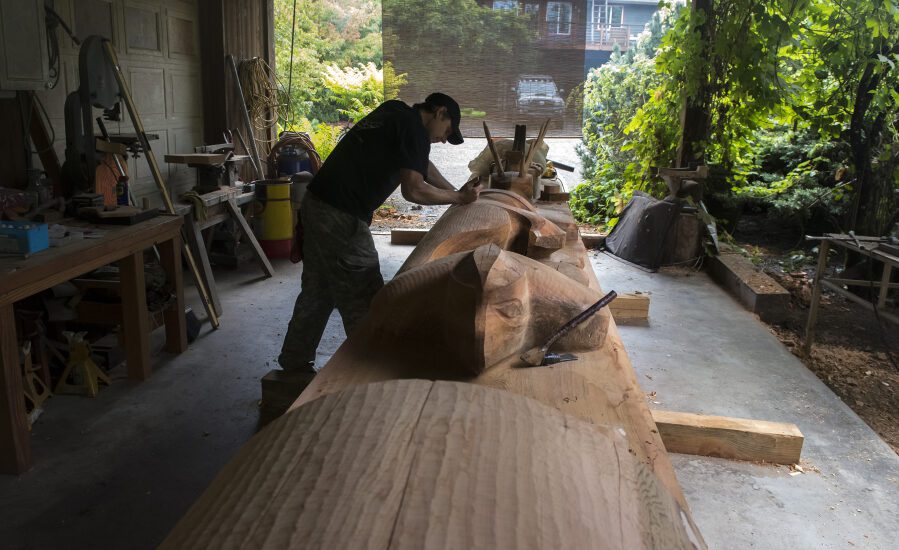The Columbian
By Scott Hewitt
LA CENTER — Long, long ago, people hit their heads on the sky because it was too low. Tribes worked together to lift the sky with cedar poles, but some beings got stuck up where they didn’t belong — including the songs of the birds, Elk and two brothers in a canoe. The bird people held a competition to fly high and get their songs back, but Elk and the brothers are still up there now. Elk is what we call the constellation Ursa Major, and the brothers in their canoe are the constellation Cepheus.
Those brothers are paddling their canoe down a massive story pole now nearing completion in artist and carver Adam McIsaac’s workshop south of La Center.
McIsaac, 46, is passionate about Native American art, but his career as an artist and carver was slow to take off for an obvious reason: he’s a white guy.
For every commission or job he’s won over the past 15 years or so, he said, a couple dozen other applications were rejected by nervous white people who don’t understand Native American art and don’t see how McIsaac’s pieces could possibly be considered “authentic.”
“It’s crazy that the whites are the ones who don’t understand,” said McIsaac, who lives with his wife and three children in a house he built with buddies. “The Natives have had no problem with me doing it for years. That’s been very validating.”
The high-altitude, tight-grained cedar trunk in his workshop weighed 6,000 pounds when it was trucked all the way from Ketchican, Alaska, McIsaac said. When his carving and painting job is done the pole will head up to a new Puyallup casino in Tacoma that’s forecast by the tribe to be a lit-up festival of glitz rivaling Las Vegas.
The pole’s design is by Shaun Peterson, a member of the Puyallup Tribe, and it’s got a different look — a more northern tribal look — than the local, so-called Lower Columbia River style that McIsaac has adopted. McIsaac, who spent years studying the nuances of different regional and tribal art styles before settling on the Lower Columbia style, said he’s honored by the Puyallup job.
“I love working with other artists and other traditions,” he said. “I keep learning so much.”

Personal, spiritual
McIsaac grew up in Hockinson and inherited a connection with the natural world and local history from his father, a fisheries biologist who worked closely with local tribes, he said.
McIsaac grew up fascinated by tribal wisdom, life skills and mythologies. He got into carving while attending outdoor-living schools, he said.
“I fell in love with wood,” he said. “I have the ability to see into a piece of wood better than I can see a design on a piece of paper.”
McIsaac scored a prized apprenticeship with Seattle artist Duane Pasco, and since then he’s traveled to Native American communities and reservations all over the Northwest and studied with many indigenous artists, including Greg Robinson, Tony Johnson and Travis Mercier.
“For a long time I studied the northern style of Northwest coast art,” he said. “But that didn’t play a part in this area, where we live.”
McIsaac found himself drawn to the indigenous Chinookan, or Lower Columbia River, art style — which looks rawer, more geometric, “older and more organic” than more fanciful, Asiatic-looking northern styles, he said.
The most famous example of the Lower Columbia style is the simple-yet-mystical face of “She Who Watches,” the ancient petroglyph at Horsethief Lake, McIsaac said. Unlike tribal art that aims to embrace whole communities and origin stories, McIsaac said, the Lower Columbia style is individual and enigmatic.
“It’s very personal art,” he said. “Personal spiritual experiences” are the main focus, according to a 2013 essay that McIsaac co-wrote for Portland State University. His own experience growing into the art was pretty mystical too: “I feel like this art form chose me,” he said.
For various historical reasons, the paper says, northern styles grew popular while the Lower Columbia style just about disappeared. McIsaac has worked hard to reverse that, he said.
“I’ve spent a lifetime working with native tribes and establishing apprenticeship programs and carving programs on reservations,” he said. “I’m not just taking from the art. I’m giving back and being part of those communities.”
Before that, he added, he sought and secured the blessing of the Chinook tribal council. “They gave me the thumbs-up,” he said.
Pinnacle
About 15 years ago, when he was invited to make art panels for Skamania Lodge, McIsaac replied that the suggested style didn’t belong to the Lower Columbia area.
“People who don’t really know are in a position to say it’s legitimate, and make decisions about it,” he said. “I told them about the indigenous style of this area, and they liked it.”
Skamania Lodge accepted his correction, he said, and hired him.
“It was a pinnacle moment for me,” McIsaac said. “Everything started to click.”
McIsaac used to peddle small objects and tools at art and craft fairs, but he started getting big jobs that drew on his expertise.
He worked on the Cathlapotle Plankhouse at the Ridgefield National Wildlife Refuge and an art panel at Columbia Valley Elementary School in east Vancouver.
Upcoming jobs are artworks for the new “Gathering Place at Washuxwal” alongside the Two Rivers Museum in Washougal, and a paddle sculpture (in collaboration with Chinook artist Tony Johnson) to be displayed outside the Burke Museum of Natural History and Culture in Seattle.
All of which is evidence that the Lower Columbia style is back in a big way, McIsaac said. “It was a style that lay dormant until I picked it up again,” he said. “It will be very validating when the Burke puts it in front of their museum, where thousands of people are going to see





